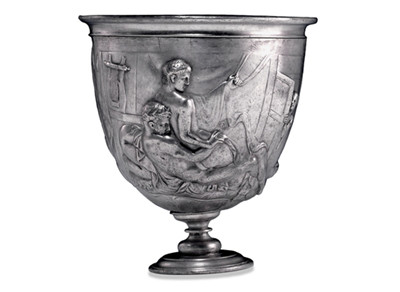Looking at the scenes on the cup more closely, there's no doubt where these encounters are taking place. The musical instruments, the furniture, the clothes and the hairstyles of the lovers, all point to the past-and indeed to the Classical Greece of several centuries earlier. Interestingly, we can tell that the two adolescents shown here were not slaves. The style of their hair-cut, with a long lock of hair trailing down the neck, is typical of free-born Greek boys. Between 16 and 18, their hair would be cut and dedicated to the gods as part of their passage into manhood. So both the boys that we see here are free, and from good families. But we can also see another figure, who might have been part of the Roman banquet at which the cup was used. He stands in the background, peeping at one of the scenes of love-making from behind a door-we only see half his face. He is clearly a slave, although it is impossible to know whether he is simply indulging in a bit of voyeurism, or apprehensively responding to a call for "room service". Either way he's a reminder that what he and we are witnessing are acts to be conducted only in private behind closed doors. Here's Bettany Hughes again:













